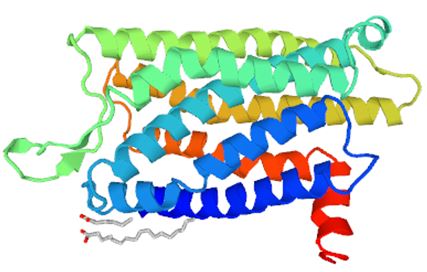Introduction of SSTR4
SSTR4 (Somatostatin Receptor 4) is a protein that in human is encoded by the SSTR4 gene. And it belongs to the G-protein coupled receptor superfamily (GPCR). SSTR4 has extracellular N-linked glycosylation sites (N-termini, second extracellular loop), a disulphide bridge (between the first two extracellular loops) and many intracellular phosphorylation sites (second and third intracellular loops and C-termini). Its biological effects of somatostatins are mediated by a family of G-protein coupled somatostatin receptors that are expressed in a tissue-specific manner. SSTR4 is functionally coupled to adenylyl cyclase.
| Basic Information of SSTR4 | |
| Protein Name | Somatostatin receptor type 4 |
| Gene Name | SSTR4 |
| Aliases | SS-4-R, SS4-R, SSTR4 |
| Organism | Homo sapiens (Human) |
| UniProt ID | P31391 |
| Transmembrane Times | 7 |
| Length (aa) | 388 |
| Sequence |
MSAPSTLPPGGEEGLGTAWPSAANASSAPAEAEEAVAGPGDARAAGMVAIQCIYALVCLVGLVGNALVIF VILRYAKMKTATNIYLLNLAVADELFMLSVPFVASSAALRHWPFGSVLCRAVLSVDGLNMFTSVFCLTVL SVDRYVAVVHPLRAATYRRPSVAKLINLGVWLASLLVTLPIAIFADTRPARGGQAVACNLQWPHPAWSAV FVVYTFLLGFLLPVLAIGLCYLLIVGKMRAVALRAGWQQRRRSEKKITRLVLMVVVVFVLCWMPFYVVQL LNLFVTSLDATVNHVSLILSYANSCANPILYGFLSDNFRRFFQRVLCLRCCLLEGAGGAEEEPLDYYATA LKSKGGAGCMCPPLPCQQEALQPEPGRKRIPLTRTTTF |
Function of SSTR4 Membrane Protein
Somatostatins are peptide hormones that regulate diverse cellular functions such as neurotransmission, cell proliferation, and endocrine signaling as well as inhibiting the release of many hormones and other secretory proteins. The activity of SSTR4 is mediated by G proteins which inhibits adenylyl cyclase. It is functionally coupled not only to inhibition of adenylate cyclase, but also to activation of both arachidonate release and mitogen-activated protein (MAP) kinase cascade. The study shows SSTR4 is a member of the superfamily of receptors which have seven transmembrane segments and is expressed in highest levels in fetal and adult brain and lung. Receptors SSTR1, SSTR2 and SSTR4, located on neurones in the hypothalamus, were thought to mediate opposing effects via different signal transduction mechanisms: SST1 and SST4 enhancing the response to glutamate.
 Fig.1 Structure of SSTR4 membrane protein.
Fig.1 Structure of SSTR4 membrane protein.
Application of SSTR4 Membrane Protein in Literature
This article determines the expression of the SSTR subtypes via immunohistochemistry analyses and assesses the correlation between SSTR subtype expression and prognosis. And data showed that the distribution of somatostatin receptor (SSTR) subtypes among the 199 pancreatic neuroendocrine tumors (PNETs) was: SSTR2 (54.8%), SSTR1 (53.3%), SSTR4 (51.8%), SSTR5 (33.7%), and SSTR3 (28.6%).
This article found that deregulated somatostatin signaling in the AD cortices studied cannot be explained by hypermethylation of the SST or SSTR4 promoter CpG islands.
Author of this group identifies that cytostatic effects in MPM are mediated by SSTR4, being inhibited by the interaction of CD26 molecules. They think combination therapy with humanized anti-CD26 mAb and SSTR4 agonist may therefore potentiate anti-tumour effect on MPM.
This article explores the correlation between the SSTR subtype messenger RNA (mRNA) expression and clinicopathological features of PET. And the data also shows the mRNA levels of SSTR1, SSTR2, SSTR3, and SSTR5 were high in PET compared with AC, whereas the expression of SSTR4 was low in PET and AC.
This article analyzes 39 somatotrophinomas patients treated with somatostain analogs, and found the most expressed SSTR was SSTR5, SSTR3, SSTR2, SSTR1, and SSTR4, respectively.
SSTR4 Preparation Options
To obtain the soluble and functional target protein, the versatile Magic™ membrane protein production platform in Creative Biolabs enables many flexible options, from which you can always find a better match for your particular project. Aided by our versatile Magic™ anti-membrane protein antibody discovery platform, we also provide customized anti-SSTR4 antibody development services.
As a forward-looking research institute as well as a leading customer service provider in the field of membrane protein, Creative Biolabs has won good reputation among our worldwide customers for successfully accomplishing numerous challenging projects including generation of many functional membrane proteins. Please feel free to contact us for more information.
All listed services and products are For Research Use Only. Do Not use in any diagnostic or therapeutic applications.